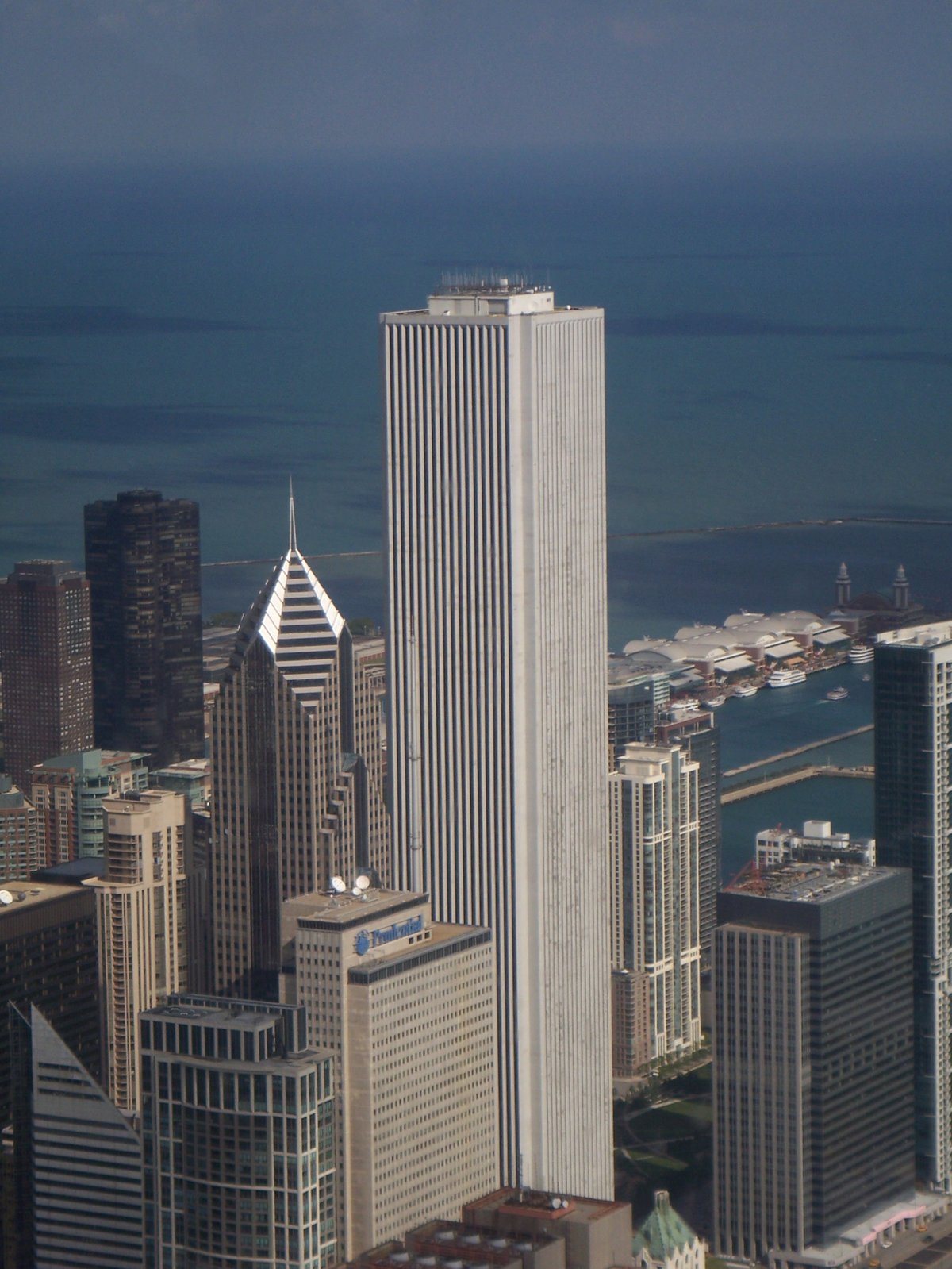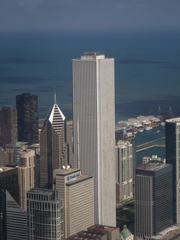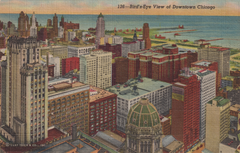
Pittsfield Building Chicago: Visiting Hours, Tickets, and Historical Sites Guide
Date: 15/06/2025
Introduction
Located at 55 East Washington Street in Chicago’s vibrant Loop, the Pittsfield Building is a distinguished skyscraper and a testament to the city’s architectural ambition. Completed in 1927 by Graham, Anderson, Probst & White, this 38-story marvel was once the tallest building in Chicago and remains a celebrated example of Art Deco and Spanish Gothic Revival design. Its historical and cultural importance, underscored by its Chicago Landmark status (designated in 2002), makes it a must-see for architecture enthusiasts and urban explorers.
Today, the Pittsfield Building bridges Chicago’s storied past and its dynamic present. Visitors can enjoy the grandeur of its marble lobby and dine at the well-loved Pittsfield Café. Although upper floors are reserved for residents or are undergoing conversion to housing, the building frequently features on walking tours exploring Chicago’s architectural heritage. Its proximity to Millennium Park, the Art Institute of Chicago, and other Loop attractions further enhances its appeal.
This guide offers comprehensive details on visiting hours, ticketing, accessibility, historical context, redevelopment efforts, nearby attractions, and practical tips to help you plan your experience at one of Chicago’s most iconic historic sites (Urbanize Chicago; CTBUH News; Chicago Detours).
Contents
- Architectural Origins and Early History
- Landmark Status and Cultural Significance
- Visiting Hours and Ticket Information
- Guided Tours and Visitor Experience
- Accessibility
- Getting There and Nearby Attractions
- Evolution of Use and Adaptive Reuse
- Complex Ownership History
- Preservation and Renovation Efforts
- Essential Visitor Tips
- Frequently Asked Questions (FAQ)
- Visual and Interactive Elements
- Internal and External Resources
- Conclusion
Architectural Origins and Early History
The Pittsfield Building was completed in 1927, designed by the renowned firm Graham, Anderson, Probst & White, also responsible for other Chicago landmarks such as the Wrigley Building and Merchandise Mart. Upon completion, the Pittsfield Building’s 38 stories made it Chicago’s tallest skyscraper until 1930. Its steel-frame construction and distinctive setbacks—mandated by the 1923 zoning ordinance—enabled unprecedented height while creating a recognizable silhouette on the skyline.
The building is a masterwork of Art Deco, featuring vertical emphasis, ornate terra cotta, and a prominent decorative crown. The original use was as an office tower for professionals in Chicago’s burgeoning business district (Urbanize Chicago).
Landmark Status and Cultural Significance
In 2002, the Pittsfield Building was designated a Chicago Landmark, acknowledging its architectural importance and its role in the city’s rapid growth during the Roaring Twenties. The lobby’s marble finishes, decorative metalwork, and grand proportions are highlights for visitors, reflecting the building’s original opulence.
The building has long been a commercial and social anchor in the Loop, with the ground floor hosting notable retailers and the Pittsfield Café, a classic diner beloved by locals and visitors alike (Pittsfield Café Menu).
Visiting Hours and Ticket Information
- Lobby Access: Monday–Friday, 8:00 AM – 6:00 PM
- Pittsfield Café: Daily, 7:00 AM – 3:00 PM
- Tickets: No tickets required for entry to the lobby or café. Upper floors are private and not open to the public.
Due to ongoing renovations, visitors are encouraged to check for current access information before visiting.
Guided Tours and Visitor Experience
The Pittsfield Building does not offer official public tours, but it is regularly featured in architectural walking tours of the Loop. These tours provide context on the building’s Art Deco design and its significance in Chicago’s architectural evolution. Photography is permitted in public areas, though visitors should be mindful of residents and business operations.
Accessibility
The Pittsfield Building features elevators and accessible entrances in public areas, making it generally wheelchair-friendly. However, ongoing renovations may temporarily affect accessibility in some sections. It is advisable to verify the latest conditions prior to your visit (CTBUH Pittsfield Building; Choose Chicago: Accessibility).
Getting There and Nearby Attractions
Transportation:
- Easily accessible by CTA Red, Blue, Brown, Green, Pink, and Orange Lines
- Multiple bus routes nearby
- Located amid Chicago’s top historic and cultural attractions
Nearby Sites:
- Millennium Park
- Art Institute of Chicago
- Chicago Cultural Center
- The Chicago Theatre
- Historic Jewelers Row
(Tour2026: Exploring Chicago 2025)
Evolution of Use and Adaptive Reuse
Initially designed for professional offices, the Pittsfield Building has evolved in response to changing urban demands. With a decline in office tenants, upper floors have been converted into residential apartments and, at times, student housing (notably Fornelli Hall from 2008) (CTBUH Pittsfield Building). Ongoing redevelopment aims to add hundreds of new residential units, including affordable housing, as part of the city’s Affordable Requirements Ordinance (Urbanize Chicago).
Complex Ownership History
Ownership of the Pittsfield Building has been notably fragmented in recent decades, contributing to delays in redevelopment.
- Marc Realty owns floors 13–21, with 177 residential units.
- Tom Liravongsa (L’Cre Global) acquired 30 of 40 floors in a 2023 foreclosure sale and is leading major residential conversion efforts.
- Legal Disputes: Previous owners faced bankruptcy and legal challenges, including litigation and asset freezes related to international investment (Crain’s Chicago Business; WBEZ Chicago).
Preservation and Renovation Efforts
Despite turbulent ownership, the Pittsfield Building’s historic exterior and key interior spaces remain largely intact, protected by landmark status. Current redevelopment, led by Pappageorge Haymes Partners, seeks to preserve these features while updating building systems and adding resident amenities, such as a new outdoor space on the 23rd floor (Urbanize Chicago).
Rezoning and city approvals are underway to facilitate the ongoing transformation, ensuring the building’s future as a vibrant residential and commercial hub.
Essential Visitor Tips
- Entry: Use the main entrance at 55 E. Washington Street; confirm lobby hours and renovation status before visiting.
- Photography: Allowed in public areas; be considerate of tenants.
- Dining: Enjoy classic breakfast and lunch at the Pittsfield Café (Pittsfield Café Menu).
- Renovations: Be aware of possible construction and temporarily restricted areas.
- Tours: Join an architectural walking tour for deeper insights (Chicago Architecture Center).
- Accessibility: Check for updates on elevator and entrance status.
Frequently Asked Questions (FAQ)
Q: What are the Pittsfield Building’s visiting hours?
A: The lobby is open Monday–Friday, 8:00 AM–6:00 PM; Pittsfield Café is open daily, 7:00 AM–3:00 PM. Upper floors are not open to the public.
Q: Do I need a ticket to visit?
A: No ticket is required for lobby or café access.
Q: Are guided tours available?
A: No official tours, but building is featured in many Loop architectural tours.
Q: Is the building wheelchair accessible?
A: Yes, in public areas, though renovations may restrict some access.
Q: What are nearby attractions?
A: Millennium Park, Art Institute of Chicago, Chicago Cultural Center, and more.
Visual and Interactive Elements
Enhance your visit with online galleries and virtual tours showcasing the Pittsfield Building’s Art Deco façade and ornate lobby. Use interactive maps for navigation and explore social media for restoration updates—particularly through developer Tom Liravongsa’s popular TikTok series (WBEZ Chicago).
Internal and External Resources
- Urbanize Chicago
- CTBUH News
- Chicago Detours
- Preservation Chicago
- WBEZ Chicago
- Pittsfield Café Menu
- CTBUH Pittsfield Building
- Chicago Architecture Center
- Choose Chicago: Accessibility
- Tour2026: Exploring Chicago 2025
Conclusion
The Pittsfield Building is a living emblem of Chicago’s architectural legacy and ongoing urban renewal. Its Art Deco elegance, storied history, and central location make it an enduring attraction for visitors and locals alike. While renovations and complex ownership have shaped its recent story, preservation efforts continue to safeguard its unique character for future generations.
Before your visit, confirm access and guided tour options, and explore the building’s evolving story through virtual and social media channels. Download the Audiala app for curated audio guides and stay engaged with Chicago’s architectural treasures.






























































































































































